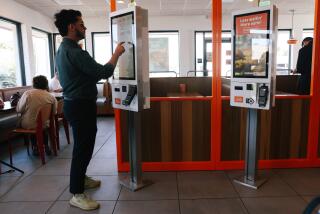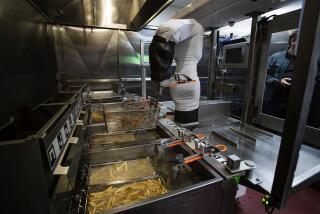Making Saving for Retirement Automatic
STERLING, Va. — Shannon Scrivens discovered a surprise in her paycheck earlier this year: It went down.
But the mother of four was happy with the modest pay cut, because the money she missed was going into a retirement savings plan.
“I noticed that the 401(k) appeared one day in my pay stub and I was thrilled with it,” said Scrivens, 35, as she took a break from her loading-dock job at a sprawling Costco warehouse near Washington Dulles International Airport.
The savings, she said, “is our only nest egg for retirement.”
Scrivens is among a growing number of workers whose employers have steered them into retirement savings plans without waiting for them to sign up. The practice, known as automatic enrollment -- or, to some workers, “forced saving” -- is a tradition-breaking effort to push people into putting money away for the future.
Under a pension overhaul bill that the House approved Friday and the Senate is due to take up this week, companies would be granted explicit legal assurance that they could unilaterally shift some of a worker’s pay into a retirement savings plan, such as a 401(k) program, unless the employee specifically opted out.
“This is by far the most important thing in the pension bill,” said John C. Goodman, president of the National Center for Policy Analysis. “It will lead to substantially more people being in the system.”
That, in turn, also could have ramifications for the economy: At a time when consumer spending is weakening, forced saving could worsen that trend by cutting into workers’ disposable income.
But advocates say the long-term benefits are worth any short-term pain. They see automatic enrollment as one way to lift the nation’s abysmal personal savings rate, which by the government’s measure has been negative for 15 consecutive months -- meaning that Americans, on balance, have been spending more than they’ve earned.
Congress’ move to bless automatic enrollment also recognizes that employer-sponsored savings plans increasingly are the only type of pension program available to many workers in an era when traditional pensions are being curbed, experts say.
More than 70 million people are covered by 401(k) or similar savings plans, compared with 44 million beneficiaries of conventional pension plans, under which companies guarantee a set level of monthly income in retirement.
About 24% of major employers automatically deduct a portion of workers’ pay for retirement savings plans, a figure that has risen from 7% in 1999, according to a survey by benefits consulting firm Hewitt Associates.
What’s more, half the remaining firms in the survey said they were considering moving to forced saving this year.
They may feel freer to act because of the pension bill, which would give employers new latitude in running workplace savings programs. One provision would ensure that automatic payroll deductions wouldn’t violate state wage garnishment laws, a concern that has held some companies back.
The bill also would allow financial services firms that manage retirement plans for companies to advise workers on choosing specific investment options in their plans -- say, a U.S. stock mutual fund or a foreign stock fund.
Many retirement plan managers have been prohibited from offering advice because of fear of conflicts of interest, but advocates in Congress argued that workers would benefit from such guidance.
With the new legislation, “you will see a truly massive redesign of the 401(k) plans,” predicted David Wray, president of the Profit Sharing/401(k) Council of America.
There has been no major organized opposition to automatic enrollment, although some Wall Street critics have been suspicious of the investment industry’s motives in championing the idea. A larger flow of money to 401(k) plans, after all, would mean heftier fees for companies that manage mutual funds and other 401(k) investments.
In addition, top executives at companies have a vested interest in boosting 401(k) participation: Tax rules may allow them to save more themselves in the plans if a larger number of lower-paid workers enroll.
Proponents of automatic enrollment say the initiative may be the best way to address the human traits of inertia and procrastination that can be enemies of saving. Once people are in a savings plan, that same inertia might work to keep them there.
“It takes some effort to look up a phone number and call someone in the plan and say no,” said John Matthews, senior vice president for human resources at retailer Costco’s headquarters in Issaquah, Wash. “Most people won’t.”
Scrivens is covered by a Costco plan that funnels 3% of the pay of each new hire into the company’s 401(k) plan. Nine out of 10 recent hires have stayed in the program, which began last year, the company says; in the past, most of those workers would not have sought to enroll, experts say.
Scrivens, who worked previously as a waitress and a preschool teacher, acknowledged, “If I had to take the time to fill out the paperwork, it would not have been completed. To tell you the truth, I have all the Costco information that they first gave me in a folder, and I haven’t looked through it.”
When NexAir, a Memphis, Tenn.-based distributor of gases and welding supplies, began to automatically enroll people in its retirement savings plan a year ago, it already enjoyed an above-average 80% employee participation rate in the program.
Today, all but four of the company’s 317 employees are in.
“Eighty percent was a good number, but 99% is a great number,” said Barbara Sizemore, the company’s benefits manager.
Participation by low-paid workers -- who are least likely to have any savings at all -- has improved significantly with automatic enrollment, studies show.
For workers in the bottom quarter of the wage scale, savings plan participation rates have jumped from as little as 42% to more than 90% after automatic enrollment was introduced, according to an analysis by the Employee Benefit Research Institute and the Investment Company Institute.
Miguel Artega, 21, had never heard of a 401(k) plan when Costco enrolled him around the beginning of this year. But the Bolivian immigrant had no complaints about the company depositing 3% of his pay into the savings program.
“It’s hard to put the money away,” said Artega, who helps run the food court at the company’s Sterling, Va., warehouse.
Indeed, one issue with forced-saving programs is that the reduction of take-home pay can make it more challenging for workers to keep up with their bills.
But workers also give up a lot, in the longer run, if they fail to participate, experts say. For one thing, many companies match some portion of what employees put into their accounts. Workers who don’t participate forgo that company contribution.
In addition, the amount deducted comes out of a worker’s pay before taxes, which lowers his or her income tax bill. And the entire account is sheltered from taxes until the money is withdrawn.
For many people, 401(k) and similar plans also may offer the only simple way to invest in stocks, bonds and other securities that historically have provided better returns than, say, bank savings accounts.
With higher potential returns, however, comes higher risk. Although many companies that automatically enroll workers in 401(k) plans put the money into the most conservative plan investment choices, employees are free to move the money into more aggressive options.
One risk is that some workers could hurt themselves by betting too heavily on investments that then backfire.
Art Comings, who was a systems analyst at telephone company Ameritech in Chicago, was keenly aware of his 401(k) account balance as retirement approached. In the late 1990s, Wall Street kept bidding up the price of his company’s shares, and he bet that the stock would keep rising. He ultimately shifted all the assets into Ameritech shares.
Then the market tumbled beginning in 2000, and so did Comings’ retirement savings. He lost nearly a third of his nest egg.
“I went the wrong way,” recalled Comings, 68, who retired two years ago.
Even so, Comings remains a fan of 401(k) plans. He said he advises his children to “put as much as you can afford in, diversify as much as the plan will let you, and then don’t touch it.”
Supporters of the pension-bill provision that would allow savings plan management companies to offer guidance to workers say that could reduce the potential for missteps as workers save more in the programs.
Also, a popular choice in many 401(k) plans now is the so-called life-cycle fund, which automatically changes its investment mix over time so the employee doesn’t have to make those asset shifts. A life-cycle fund’s holdings typically become more conservative as the worker gets closer to retirement age.
Despite the risks, employer-sponsored savings plans offer the best way for millions to provide themselves with a retirement nest egg, many experts say. Automatic enrollment could help more people get started down that road, they say.
“The only way that Americans are going to retire with any sort of financial dignity is if [retirement savings] plans get everything right in the next five years,” said Charles Ruffel, head of PlanSponsor, a Web-based information firm that monitors trends in the pension world.
With traditional pension plans fading and the future of Social Security in question, he said, “What else is left?”
More to Read
Inside the business of entertainment
The Wide Shot brings you news, analysis and insights on everything from streaming wars to production — and what it all means for the future.
You may occasionally receive promotional content from the Los Angeles Times.










